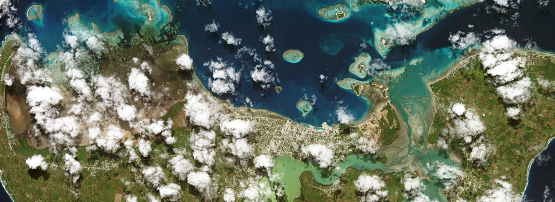
In just a few days, APNIC 58 will be held in Wellington, New Zealand. To celebrate APNIC 58’s host economy, on the blog and throughout the conference we’ll be looking at the Internet operations of our host economy, and its regional surrounds, in which New Zealand plays a major role.
The Tonga Communications Corporation (TCC) has been actively deploying IPv6 across its network, aiming to enhance Internet connectivity and future-proof its infrastructure. This blog post provides an overview of TCC’s IPv6 deployment in fixed and cellular networks, the challenges faced, the lessons learned, and future plans.
The Kingdom of Tonga is a Polynesian economy northeast of New Zealand. It comprises 176 islands, with 36 inhabited by around 106,000 people. The islands are grouped into four main clusters: Tongatapu, Ha’apai, Vava’u, and the Niuas. The capital, Nuku’alofa, is on the main island of Tongatapu.
TCC is a comprehensive telecom in Tonga, managing ISP core, fixed, and cellular broadband services. With over 80,000 cellular subscribers and 5,000 fixed broadband users, TCC plays a critical role in Tonga’s connectivity. TCC began its IPv6 journey in 2009, acquiring a /36 IPv6 allocation from APNIC. The project, which gained momentum in 2022, is supported by ISIF Asia.
By 2019, TCC’s fixed network was fully IPv6-ready without requiring additional capital expenditure. The deployment process involved several key steps. Dual-stack configurations were enabled, extending from the upstream international gateway in Fiji to subscribers’ CPEs. This was complemented by configuring border routers, PE cores with MPLS VPN, dual-stack DNS resolvers, BRAS for PPPoE dual-stack, and MSANs to support both IPv4 and IPv6 frames. ADSL and FTTH CPEs were equipped to handle dual-stack, although some cellular CPEs were not yet compatible.
The cellular network’s IPv6 deployment focused on TCC’s Ucall Mobile brand. The evolution of the network began with 1G in 1998 and progressed to 4G by 2014. By 2022, the network had expanded to cover over 95% of Tonga with 4G and 4G+ services, supporting more than 80,000 subscribers. The deployment process included conducting thorough network audits to identify necessary physical and logical changes. Dual-stack configurations were implemented, and transition technologies like 464XLAT were considered. Additionally, direct IPv6 links were established from the mobile core to border routers, while maintaining the existing IPv4 infrastructure to ensure a smooth transition.
Why deploy IPv6?
Since the government successfully commissioned an international fibre cable in 2013, Internet speed and latency in Tonga have improved significantly compared to when we relied on satellite connections. However, this progress brought new challenges, such as increased network resource consumption due to rising demand from TCC subscribers, which was constrained by the network’s capacity.
By 2014, TCC had established a 3G-capable network, and over the following years, LTE was introduced in specific areas, primarily in central Nuku’alofa. By 2018, TCC’s 4G network coverage had expanded to nearly all of Tongatapu, the main island, and even extended to three other major island groups.
This rapid development over the five years from 2014 to 2018 led to a threefold increase in bandwidth and network resource demand. On the network side, we encountered limitations related to NAT44 capacity because we used RFC 1918 addresses to allow mobile handsets to access the Internet. Although we had sufficient private and public IP addresses for NAT44, we ran out of TCP resources and hit hardware limitations in our firewall, which was responsible for NAT44 for our customer mobile traffic. This necessitated costly firewall upgrades.
Given that most of this mobile data traffic is IPv6-ready on the Internet, we decided to deploy IPv6 to eliminate the ongoing financial burden on our capital expenditure associated with NAT44 for translating private IPv4 to public IP for Internet access.
During these years we learned that deploying IPv6 on TCC’s cellular network offers several advantages:
Enhanced competitiveness: Adopting IPv6 would enable TCC to stay competitive within the region by offering the latest technology to its customers, showcasing the company’s commitment to innovation and staying ahead in the industry.
Future-proofing the network: Deploying IPv6 future-proofs TCC’s network, paving the way for advancements like IoT and other cutting-edge technologies to become a reality for our Ucall Mobile customers.
Independence from vendor specifications: Instead of relying on vendors to dictate what should be implemented, TCC can proactively move forward with IPv6 deployments. This approach not only allows TCC to maintain independence from vendor decisions but also proves to be more cost-effective, as we discovered during our deployments.
Additionally, a rare but significant incident highlighted the value of IPv6. When we experienced an issue with upstream IPv4 transit connectivity, IPv6 allowed our fixed-line customers to access the Internet seamlessly, without even noticing the problem. Without IPv6, this could have led to a complete Internet outage for our fixed-line customers before this project.
Deployment stages
1. Gathering information
During this initial stage, our team consulted with the current vendor to assess IPv6 support on our mobile network. The vendor provided quotations for the necessary licenses and services at that time.
2. Redirecting traffic away from the firewall
A key consideration during the implementation phase was to avoid any Internet service outages for our subscribers. To address this, engineers from both the mobile and ISP teams engaged in discussions, leading to a proposed solution — redirecting traffic through new physical links and enabling dual-stack on some of these links to provide dual-stack for our mobile subscribers.
3. Mobile core node configuration
This step was executed by TCC’s Value-Added Service Support Engineer, with assistance from our mobile engineers, but that’s a whole other story.
4. Incoming professional consultation
To ensure the success of the project, we engaged a specialized IPv6 company to provide in-house training and consultation services. This resulted in an intensive two-week training program for the TCC project team and other relevant staff from TCC engineering and other departments.
5. Training and promotional activities
TCC local staff training — our project team recognized the importance of ensuring that TCC internal staff were fully informed about the project before reaching out to external groups such as customers, stakeholders, or the general public. Training sessions were conducted not only for TCC front-line staff on Tongatapu but also on other major islands.
IPv6 awareness events for the public — it was identified that for both iOS and Android devices, enabling IPv6 often required user action, such as upgrading their iOS device or changing Access Point Name (APN) settings on Android devices. To address this, targeted awareness programs were conducted, focusing on government ministries and selected organizations.
Since it wasn’t feasible to conduct awareness sessions for all mobile subscribers, we broadcast messages to the public, informing them that IPv6 is now available on the TCC network and providing details on how to enable it.
Dealing with the challenges
Despite certain technical complexities involved in implementing IPv6 on our mobile network, we actually found this aspect of deployment the least challenging. Although there were technical hurdles, such as redirecting IPv6 traffic without disrupting production traffic, these tasks were easier to manage because they fell within the control of our project team.
The real challenges arose when dealing with factors beyond our control, particularly those related to iOS vendors and Android users. Addressing issues with Android users was relatively straightforward — we continued to broadcast messages instructing them on how to adjust their APN settings. However, the situation with iOS presented more significant challenges. Apple confirmed that, for now, TCC can only support dual-stack on compatible iPhones, with no support for CLATd functionality. This means that many iOS users (iPhone 10 and below) will remain on IPv4 until they upgrade to compatible handsets.
While these technical challenges will persist for the foreseeable future, the project has had a positive impact on our team. Instead of having individuals handle internal training and public awareness programs, we opted to form teams of four or five to manage these events. This approach boosted morale and fostered greater collaboration among team members, allowing us to understand each other’s personalities more closely — a level of camaraderie that didn’t exist before the project. Even after the training, the team has been more willing to work together on tasks unrelated to the project.
We also tackled other initiatives, such as deploying IPv6 on our fixed-line network. Since we don’t have an auto-configuration server to enable IPv6 on ADSL modems, we relied on staff to conduct home visits, a move approved by TCC management. This allowed us to enable IPv6 for fixed-line subscribers as well.
A key lesson we learned from this project is that delaying the implementation of IPv6 can result in a growing number of unsupported iOS devices. In our case, Apple confirmed that only iPhone 11 and newer models are compatible with the latest iOS version supporting IPv6 dual-stack. iPhone 10 and older models will remain on IPv4 until users upgrade their devices. If we had waited another five years before deploying IPv6, and Apple had stopped supporting iPhone 12 and below, a larger group of iOS users would have been left without IPv6. Unfortunately, there seems to be no way to communicate with Apple to allow incompatible devices to work on IPv6 with newer software, so we have to work within these limitations.
What we learned
A key lesson we learned from this project is that delaying the implementation of IPv6 can result in a growing number of unsupported iOS devices. In our case, Apple confirmed that only iPhone 11 and newer models are compatible with the latest iOS version supporting IPv6 dual-stack. iPhone 10 and older models will remain on IPv4 until users upgrade their devices. If we had waited another five years before deploying IPv6, and Apple had stopped supporting iPhone 12 and below, a larger group of iOS users would have been left without IPv6. Unfortunately, there seems to be no way to communicate with Apple to allow incompatible devices to work on IPv6 with newer software, so we must work within these limitations.
Here are some specific lessons we’d like to share with anyone deploying IPv6:
Know your network: Before approaching your vendor, thoroughly review your current IPv4 network. Understand all its aspects so that your vendor can’t surprise you with unexpected issues.
Share your vision: Communicate your plans and ask for assistance in achieving them. This can help you find a good IPv6 mentor. Attending conferences and Network Operators Group (NOG) meetings is a great way to connect with experts in relevant fields.
Stay curious: Don’t be afraid to make mistakes or ask questions. Curiosity is key to learning and progressing in IPv6 deployment.
Seek funding: If your organization lacks the funds to deploy IPv6, explore available financial resources and submit funding proposals.
Prioritize Apple: Treat Apple as critical from the start and deploy IPv6 as soon as possible. Apple does not provide technical support or updates for handsets they no longer support.
Plan for mobile end users: Both Android and iOS devices require manual user intervention to enable IPv6. It’s important to plan how you’ll address this from the beginning. In our case, if we had known this earlier, we would have broadcast messages about IPv6 enablement from the start. This would have increased user awareness and potentially led to higher adoption rates once the network deployment was completed.
Monitor user adoption: We are approaching the 12-month mark since we enabled IPv6 dual-stack on our cellular production network (Ucall Mobile) on 30 August 2023. So far, we’ve seen only about 25 to 30% of our traffic on IPv6, which is below our expectations. Most of our mobile user traffic involves streaming, social media, and other activities that prefer IPv6 on dual-stack or IPv6-only services.
Statistics and user adoption
Currently, TCC is the only Tongan provider with a visible commitment to IPv6 as shown by APNIC Labs. APNIC Labs statistics indicate a growing, yet gradual, adoption of IPv6. In August 2023, APNIC Labs was showing Tonga as ~1% IPv6 capable. Currently, in August 2024, that figure sits at 26% (Figure 1).
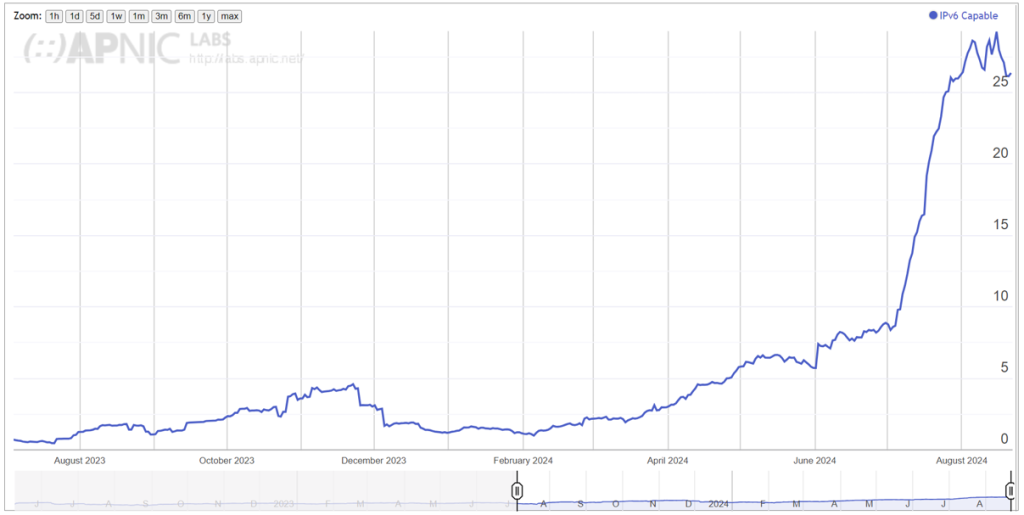
Future plans
TCC is aiming to further enhance its network by implementing several key initiatives. These include introducing public Wi-Fi SSIDs with NAT64 support and modernizing the mobile core infrastructure to fully support IPv6. TCC also plans to expand services such as VoLTE and prepare for future 5G deployments. Additionally, we will continue our campaign to update user devices and APN settings to increase IPv6 traffic.
TCC’s commitment to deploying IPv6 is significantly transforming Tonga’s Internet landscape, ensuring robust, scalable, and future-proof connectivity. By sharing these insights, TCC aims to contribute to the global knowledge base and support other network operators in their IPv6 transition journeys.
Mailelatamai Halatuituia is the Project Manager for TCC’s IPv6 project, an ISP Engineer at TCC, and an APNIC 46 Fellow.
This project was supported by an ISIF Asia grant from the APNIC Foundation. A full technical report will be published on the Foundation project page once the project wraps up.
Maile will share further updates on TCC’s IPv6 deployment journey during the IPv6 Deployment Session at APNIC 58. This session will also deep-dive into IPv6 adoption paths on AWS, take a detailed look at deployment in China’s IPv6-only city, Xiong’an, and comprehensively analyse Interface Identifier Patterns (IIDs) in current IPv6 deployments.
The views expressed by the authors of this blog are their own and do not necessarily reflect the views of APNIC. Please note a Code of Conduct applies to this blog.

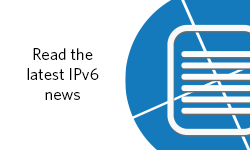
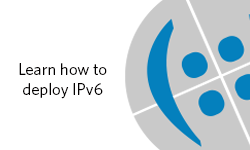

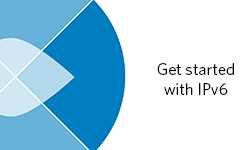
I’ve explained this several times. Apple doesn’t need a CLAT for the IOS device itself, because it uses an equivalent function embedded in the Happy Eyeballs v2.0.
However, it may be needed for the tethered devices.
This has been available from Apple for many years.
For some reason, Apple don’t like Tonga and they don’t want to enable it to you … in other regions countries, it just works when the Apple liaison is contacted, after the verify a good IPv6-only support.
Really strange what Apple is doing for Tonga!.